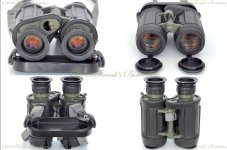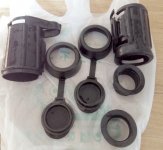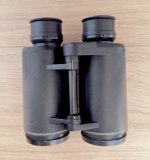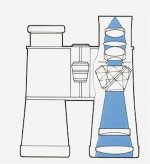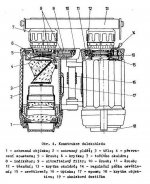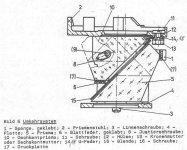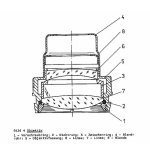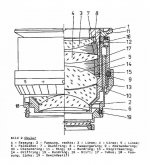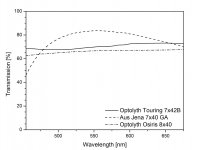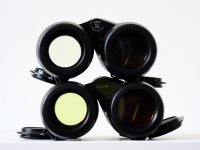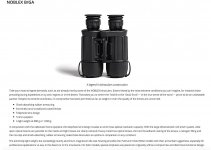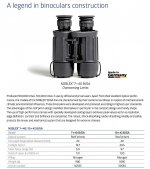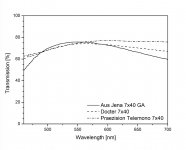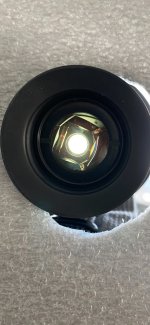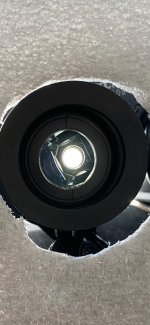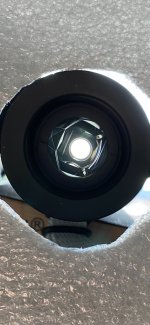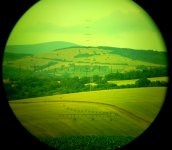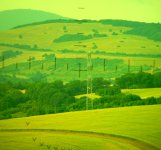John A Roberts
Well-known member

Post-WWII, the East German company of Carl Zeiss Jena produced two roof prism binoculars for the commercial market, the Notarem 8x32 and 10x40
see posts #62 and #63 at: https://www.birdforum.net/showthread.php?t=385822&page=3
CZJ also produced a different model specifically intended for military use, the EDF 7x40
(as there’s a lot of detailed information available about the EDF, for convenience I’ve listed the main links in the final post)
EDF 7x40
The EDF 7x40 was introduced in 1981. See an image from Frank Weissörtel at: https://www.flickr.com/photos/114212355@N05/48975070751
(the hole in the left prism plate is where the IR detector was, see post #4 below)
It was specifically designed for the army of the then nation of East German: the NFA/ Nationale Volksarmee of the DDR/ Deutsche Demokratische Republik
Köhler indicates that it was the result of 10 years of development, so the initial work would have dated back to the early 1970’s
(and presumedly the civilian models were an offshoot of the programme)
EDF is an abbreviation of Einheitsdoppelfernror which means ‘double telescope unit’ or ‘binocular unit’. It replaced the Porro prism DF 7x40 binocular
Identification, Design Philosophy and Durability
The EDF is immediately recognisable by the placement and asymmetric design of its hinges
As a product of the cold war era, the EDF includes provision for the most pessimistic of uses - remaining serviceable in a battlefield with high levels of background radiation
It is also known for its extreme durability e.g. see the detailed testing requirements described in the Thürnagel and MosMilTec links
This is one instance where a military binocular does differ significantly from its civilian versions
And consistent with it’s most dire usage, all of the rubber armour is user removable and replaceable; see the images from: https://m.blog.naver.com/juniell/220727060712
Optics
The commercial Notarem 8x32 and 10x40 models, seem to have the same optical construction,
with the 10x40 having a longer objective body and larger diameter objective lenses of the same pattern as the 8x32
However, while the Notarems and the EDF share a common origin, they differ in a number of ways. Firstly the EDF is an IF rather than a CF design
And it also has a number of significant optical differences
A) CONSTRUCTION
As can be seen from the images from Marco Gherardi and Holger Merlitz - compared to the Notarem 10x40 - the EDF 7x40:
- appears to have the same Schmidt-Pechan prisms (?), though presumedly in a much more substantial mounting cradle
- has a similar 2 lens/ 2 group tele-objective (though the second lens uses special glass, see below), and
- has a modified eyepiece of 5 lenses, with a markedly different rear lens, and seemingly a different spacing of the lens groups (and again the first lens uses special glass)
While the eyepiece lenses appear to be in 3 groups in a 3/ 1/ 1 pattern, as Holger notes the diagram seems to indicate that there is a minimal air gap between the second and third lenses
B) EYE RELIEF
The eyepiece construction results in 20mm of eye relief, intended to allow use with a gas mask
C) SPECIAL GLASS
In place of the usual flint glass lenses, the EDF uses a special version known as SF3R, with the R indicating radiation resistance
Regular flint glass darkens to black as a result of prolonged radiation exposure. The R version glass minimises the problem, though it does not eliminate all darkening
The glass is used for 2 of the lenses: the second lens of the objective and the first lens of the eyepiece; see Köhler
continued . . .
see posts #62 and #63 at: https://www.birdforum.net/showthread.php?t=385822&page=3
CZJ also produced a different model specifically intended for military use, the EDF 7x40
(as there’s a lot of detailed information available about the EDF, for convenience I’ve listed the main links in the final post)
EDF 7x40
The EDF 7x40 was introduced in 1981. See an image from Frank Weissörtel at: https://www.flickr.com/photos/114212355@N05/48975070751
(the hole in the left prism plate is where the IR detector was, see post #4 below)
It was specifically designed for the army of the then nation of East German: the NFA/ Nationale Volksarmee of the DDR/ Deutsche Demokratische Republik
Köhler indicates that it was the result of 10 years of development, so the initial work would have dated back to the early 1970’s
(and presumedly the civilian models were an offshoot of the programme)
EDF is an abbreviation of Einheitsdoppelfernror which means ‘double telescope unit’ or ‘binocular unit’. It replaced the Porro prism DF 7x40 binocular
Identification, Design Philosophy and Durability
The EDF is immediately recognisable by the placement and asymmetric design of its hinges
As a product of the cold war era, the EDF includes provision for the most pessimistic of uses - remaining serviceable in a battlefield with high levels of background radiation
It is also known for its extreme durability e.g. see the detailed testing requirements described in the Thürnagel and MosMilTec links
This is one instance where a military binocular does differ significantly from its civilian versions
And consistent with it’s most dire usage, all of the rubber armour is user removable and replaceable; see the images from: https://m.blog.naver.com/juniell/220727060712
Optics
The commercial Notarem 8x32 and 10x40 models, seem to have the same optical construction,
with the 10x40 having a longer objective body and larger diameter objective lenses of the same pattern as the 8x32
However, while the Notarems and the EDF share a common origin, they differ in a number of ways. Firstly the EDF is an IF rather than a CF design
And it also has a number of significant optical differences
A) CONSTRUCTION
As can be seen from the images from Marco Gherardi and Holger Merlitz - compared to the Notarem 10x40 - the EDF 7x40:
- appears to have the same Schmidt-Pechan prisms (?), though presumedly in a much more substantial mounting cradle
- has a similar 2 lens/ 2 group tele-objective (though the second lens uses special glass, see below), and
- has a modified eyepiece of 5 lenses, with a markedly different rear lens, and seemingly a different spacing of the lens groups (and again the first lens uses special glass)
While the eyepiece lenses appear to be in 3 groups in a 3/ 1/ 1 pattern, as Holger notes the diagram seems to indicate that there is a minimal air gap between the second and third lenses
B) EYE RELIEF
The eyepiece construction results in 20mm of eye relief, intended to allow use with a gas mask
C) SPECIAL GLASS
In place of the usual flint glass lenses, the EDF uses a special version known as SF3R, with the R indicating radiation resistance
Regular flint glass darkens to black as a result of prolonged radiation exposure. The R version glass minimises the problem, though it does not eliminate all darkening
The glass is used for 2 of the lenses: the second lens of the objective and the first lens of the eyepiece; see Köhler
continued . . .
Attachments
Last edited:




